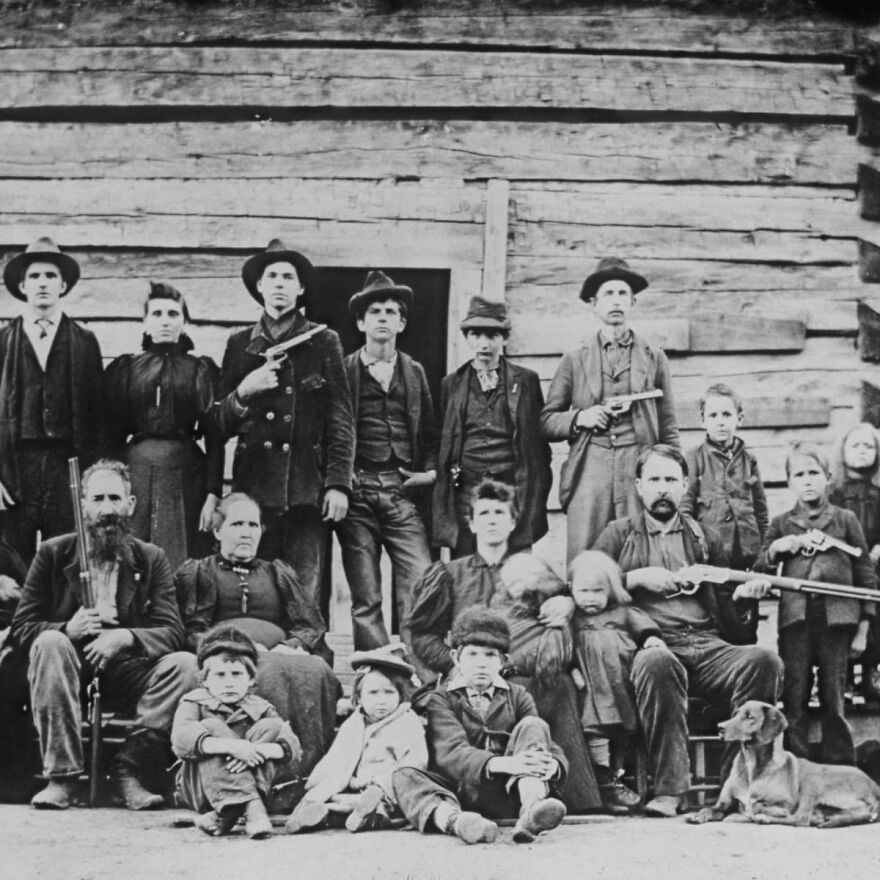History: The Hatfields & Mccoys Didn’t Always Hate Each Other
283views
I just love DNA tests. I was shocked to find that I have kin on both sides but that also told me that at some point, one from each family shared at least one intimate moment to create babies. Ironically, the video of their story was one of my favorites.
Although distant relatives going back to the 1800s, our shared surnames are: Walker, Dickey, Judge John Carson, Watson, Campbell, Mitchell, Brown, McCoy, Creps, Brown, Stevens, Hatfield, Pollock, Chafin, Davis, Barr, and others.
For many years these two families coexisted mostly peacefully. They worked together and even enjoyed intimacy at times.
There are alternatives when arguing…
America has gone from a country of hardworking people to a consumer-based society that is driven by greed, empty entertainment, political distractions, scammers, trolls, and trickery. Even our own family disagreements have lost integrity. Back in the days of the Hatfield-McCoy feuds, there were no options of going on a game show to battle it out in fun.
Quite the contrary… they just shot each other.
The most silly game show on television back in the mid-1970s, an American television game show was created. It was called Family Feud. The show featured two families who competed to name the most popular answers provided to survey questions. The questions were polled amount unrelated third parties. The family with the most points at the end of their segment won cash and prizes. This show was partly created because of the Hatfield-McCoy feud.
The feud had its roots in the Civil War.
In real life, the Hatfields and McCoys were two Appalachian clans who settled on opposite sides of a stream called Tug Fork.
This stream traveled along the West Virginia – Kentucky border.
On the West Virginia side were the Hatfields, a logging family of 15. The patriarch was “Devil Anse” Hatfield, a former Confederate officer.
Mostly on the Kentucky side was the McCoy family of 13-16 children. The patriarch was Randall McCoy.
From the fields of Kentucky and West Virginia to the U.S. Supreme Court
Eight Hatfields were arrested for murdering two people in 1888. They also stood trial for the crimes. The victims? Two of Randall McCoy’s children.
The State of West Virginia sued for the men’s release, stating they had been transported across state lines illegally. Once the Supreme Court became involved in the case (Mahon v. Justice), its 7-2 decision ruled in favor of Kentucky. This meant that the trials and subsequent convictions of the Hatfield men would continue. As a result seven of them received life sentences. Ellison “Cotton Top” Mounts was the only one who was executed.
30 years later there was another Hatfields and McCoys feud.
On May 19, 1920, in Matewan, West Virginia, anti-union Baldwin-Felts Agency hired detectives to evict the families of workers who had attempted to unionize the Stone Mountain Coal Company. The chief of police was Sid Hatfield who intervened on the miners’ behalf. That caused a violent clash which left seven detectives and four locals dead. This incident is known as the “Matewan Massacre” and it led to rallies across the USA.
It was such a nationwide outcry that it made Sid Hatfield famous. A year later, Sid Hatfield was assassinated supposedly by those same detectives. The events surrounding the Matewan Massacre and Sid’s murder were the topics of the 1987 accalimed film called Matewan.
To sum it up… although they ended the feud in 1891 and shook hands in 1976, it wasn’t until Saturday, June 14, 2003, when the official feud between the Hatfields and McCoys’ came to an end.
Finally, here are some things you likely didn’t know about their feud.
More info: history.com
HatfieldMcCoy
I just love DNA tests. I was shocked to find that I have kin on both sides but that also told me that at some point, one from each family shared at least one intimate moment to create babies. Ironically, the video of their story was one of my favorites.
Although distant relatives going back to the 1800s, our shared surnames are: Walker, Dickey, Judge John Carson, Watson, Campbell, Mitchell, Brown, McCoy, Creps, Brown, Stevens, Hatfield, Pollock, Chafin, Davis, Barr, and others.
For many years these two families coexisted mostly peacefully. They worked together and even enjoyed intimacy at times.
There are alternatives when arguing…
America has gone from a country of hardworking people to a consumer-based society that is driven by greed, empty entertainment, political distractions, scammers, trolls, and trickery. Even our own family disagreements have lost integrity. Back in the days of the Hatfield-McCoy feuds, there were no options of going on a game show to battle it out in fun.
Quite the contrary… they just shot each other.
The most silly game show on television back in the mid-1970s, an American television game show was created. It was called Family Feud. The show featured two families who competed to name the most popular answers provided to survey questions. The questions were polled amount unrelated third parties. The family with the most points at the end of their segment won cash and prizes. This show was partly created because of the Hatfield-McCoy feud.
The feud had its roots in the Civil War.
In real life, the Hatfields and McCoys were two Appalachian clans who settled on opposite sides of a stream called Tug Fork.
This stream traveled along the West Virginia – Kentucky border.
On the West Virginia side were the Hatfields, a logging family of 15. The patriarch was “Devil Anse” Hatfield, a former Confederate officer.
Mostly on the Kentucky side was the McCoy family of 13-16 children. The patriarch was Randall McCoy.
From the fields of Kentucky and West Virginia to the U.S. Supreme Court
Eight Hatfields were arrested for murdering two people in 1888. They also stood trial for the crimes. The victims? Two of Randall McCoy’s children.
The State of West Virginia sued for the men’s release, stating they had been transported across state lines illegally. Once the Supreme Court became involved in the case (Mahon v. Justice), its 7-2 decision ruled in favor of Kentucky. This meant that the trials and subsequent convictions of the Hatfield men would continue. As a result seven of them received life sentences. Ellison “Cotton Top” Mounts was the only one who was executed.
30 years later there was another Hatfields and McCoys feud.
On May 19, 1920, in Matewan, West Virginia, anti-union Baldwin-Felts Agency hired detectives to evict the families of workers who had attempted to unionize the Stone Mountain Coal Company. The chief of police was Sid Hatfield who intervened on the miners’ behalf. That caused a violent clash which left seven detectives and four locals dead. This incident is known as the “Matewan Massacre” and it led to rallies across the USA.
It was such a nationwide outcry that it made Sid Hatfield famous. A year later, Sid Hatfield was assassinated supposedly by those same detectives. The events surrounding the Matewan Massacre and Sid’s murder were the topics of the 1987 accalimed film called Matewan.
To sum it up… although they ended the feud in 1891 and shook hands in 1976, it wasn’t until Saturday, June 14, 2003, when the official feud between the Hatfields and McCoys’ came to an end.
Finally, here are some things you likely didn’t know about their feud.
More info: history.com
HatfieldMcCoy
283views
Share on Facebook




3
0